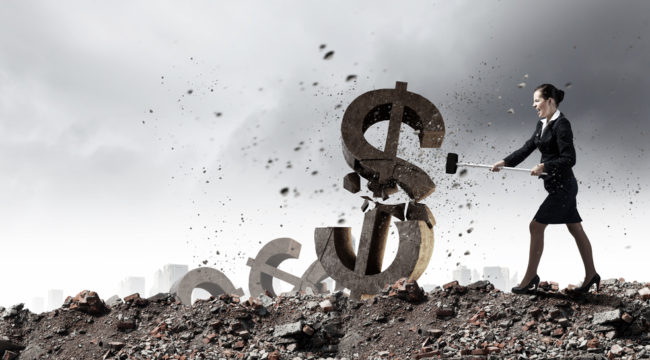History Says Crash Could Come in September
This year — like every year — gloom-and-doomers of every make and model will yell about October.
There was the Crash of 1929… “Black Monday” of 1987… the Panic of 1907. All took place in October, they warn. There’s even a term for it — the “October effect.”
But are they right? Is October really the bogeyman it’s cracked up to be?
If history is any guide, no. If anything, October has spelled the end of more bear markets than the beginning, according to Investopedia. Downturns in 1987, 1990, 2001 and 2002 all turned around in October, it reminds us.
If not October, then what month is the great menace for markets?
September…
History shows September, not October, is the month to circle. “Since the Dow Jones industrial average was created in the late 1890s,” financial columnist Mark Hulbert notes, “September has produced an average loss of 1.1%. The 11 other months of the calendar, in contrast, have produced an average gain of 0.8%.”
Nor, Hulbert adds, can September’s black record be traced to one or two dismal years: “On the contrary, the month has an impressively consistent record at or near the bottom of the rankings.”
Same with the S&P 500. The median September return for the index has been negative stretching all the way back to 1928, according to Bank of America Merrill Lynch strategist Savita Subramanian. That’s 88 years running.
The prosecution presents the following as proof thereof:

Pictures don’t lie.
It’s been a quiet, quiet August. Volatility is currently near its lowest level in 26 years. And the skies are deep azure to the horizon.
Now that the calendar’s about to flip to September, we pose a question we admit we shouldn’t ask… a question that could tempt fate even on its busiest day…
What could possibly go wrong?
Turns out the 30 days ahead are peppered with land mines that could go off with… detonative effects on the market. One of them is Sept. 21. That’s when the Fed meets to decide interest rates. It’ll be taking a hard look at August’s jobs report, due out this Friday. If it’s good it could put the Fed in a real bind. Here’s David Stockman:
After what will be 93 months crouched on the zero bound, it will have no excuse not to raise rates by 25 basis points. Especially if it continues to be deluded by the false and lagging indicators of the BLS jobs report.
But the market has most definitely not “priced in” a rate hike. It will sell off violently if the Fed goes ahead and raises rates. This has been recently suggested by its key rate strategist and Goldman man on the case, Bill Dudley, president of the New York Fed.
And if the Fed stays pat on the 21st?
On the other hand, if it punts until another time, that decision will come with new concerns. Concerns that continuing head winds from China, Europe and the rest of the world have the potential to seriously harm the struggling domestic recovery.
Then there’s the upcoming election. Markets have baked a Hillary victory into the cake. But David says not so fast. He says volatility can return tout-suite after their Sept. 26 debate. If Trump puts on a show or Hillary makes a hash of it, watch out:
Another September event could trigger volatility as well. On Sept. 26, Trump and Hillary will have their first presidential debate. The results of this debate could also blindside the market because at the moment Hillary Clinton is considered to be a shoo-in…
There is no telling what Donald Trump will do, but at this stage of the game there is absolutely no reason to think that the market has it right and that Hillary has it in the bag.
David saw it happen in 1980 when Carter was ahead late in the game. Then Reagan thumped him in their second debate and took the lead heading into the election.
Two monetary events in September could also trip a mine — a big one. And the dollar would suffer the blast. The first is when the G-20 meets Sept. 4 in Hangzhou, China. The second happens on Sept. 30, when the IMF officially accepts the Chinese yuan into its basket of currencies making up its special drawing right (SDR). Throw in the IMF meeting in Washington on Oct. 7 and the market could soon be in for quite a shake, according to Jim Rickards:
The next five weeks will mark one of the most significant transformations in the international monetary system in over 30 years. Since the dollar is still the lynchpin of this system, the dollar itself will be affected…
Such radical transformations of the international monetary system have happened many times before… What will happen in the next five weeks is just as significant as any of the previous monetary earthquakes…
The hidden agenda involves the formal transition from a dollar standard to an SDR standard in world monetary affairs.
Fed meetings that could raise rates, presidential debates that could rattle markets, monetary meetings that could hammer the dollar.
Add it together and September has a lot of mines to tiptoe around. Maybe it’ll make it through. Then again, maybe it won’t…
T.S. Eliot once said April is the cruelest month. But for markets, history says September’s the cruelest month.
Proceed with caution.
Regards,
Brian Maher
Managing editor, The Daily Reckoning
Ed. Note: Sign up for your FREE subscription to The Daily Reckoning, and you’ll start receiving regular offers for specific profit opportunities. By taking advantage now, your ensuring that you’ll be financially secure later. Best to start right away.



Comments: